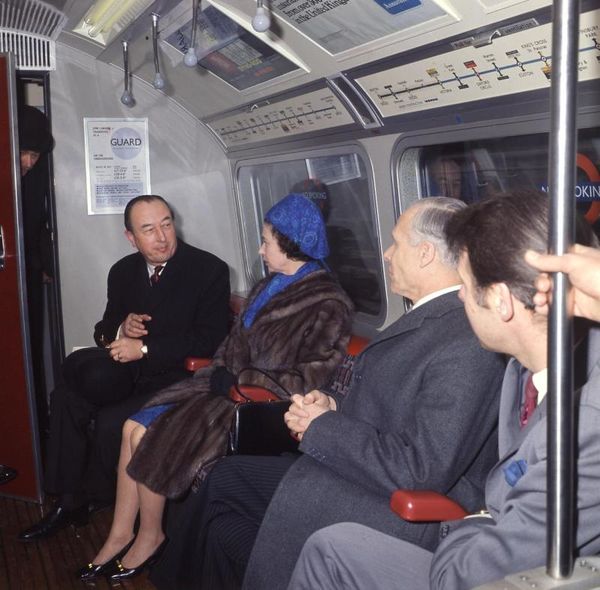
Queen Elizabeth II and London’s public transport network
Introduction
London’s world-famous public transport system has kept the city moving throughout the long lifetime and reign of Queen Elizabeth II (1926-2022).
In 2022, the Queen passed away at the age of 96. It was also the year she celebrated her Platinum Jubilee after 70 years on the throne, and officially opened London’s newest railway, the Elizabeth line, that carries her name.
In this story, we look back on the occasions when the Queen visited and travelled on London’s transport network, originally run by London Transport and, since 2000, by Transport for London (TfL).
We also highlight objects in our collection associated with these events, which could perhaps be described as among our ‘crown jewels’.
District line, 15 May 1939
A few months before the onset of the Second World War, the then Princess Elizabeth rode on the Underground for the first time at the age of 13. She is shown here on St James’s Park station platform with her sister Princess Margaret, their governess Marion Kirk Crawford (right) and Lady Helen Graham (left).
According to London Transport’s staff magazine Pennyfare, ‘Both Princesses were greatly interested in the escalators, automatic ticket-machines and automatic doors’. Despite their status, the Princesses sat in a third-class smoking car on the District line train.
Victoria line, 7 March 1969
After a 30-year absence, the Queen took her next Tube journey to mark the opening of the Victoria line.
After experiencing the new Green Park station, including its ticket barriers, she rode in the cab of the first train, operating the buttons to set the train on its short journey to Oxford Circus. While it could therefore be claimed the Queen ‘drove’ the train, the Victoria line was the first Tube line to use automatic operation.
In our collection, we care for the driving car that the Queen travelled in, as well as the commemorative headboard that decorated the front of the train.
We also hold banners, invitations and souvenir tickets, as well as the machine roll used to programme the automatic signalling on the day of the Royal opening of the Victoria line.

Piccadilly line, 16 December 1977
In the year of her Silver Jubilee, the Queen unveiled the Piccadilly line extension that connected central London to Heathrow – the first line of its kind in the world to link a capital city to its major airport. As with her trip on the Victoria line, the Queen rode in the driver’s cab. Whether deliberate or not, her outfit naturally accompanied the blue moquette fabric of the train, created by designer Marianne Straub.

Docklands Light Railway, 30 July 1987
Ten years later, the next major addition to London’s public transport network was the Docklands Light Railway (DLR) – an automated light metro system serving the redeveloped Docklands area, which later extended further across eastern parts of the city. The Queen led the ceremonial opening of the DLR, riding at the front of the first car.
Willesden Green bus garage, 6 June 2002
In 2002, the Queen went on a Golden Jubilee tour to mark 50 years on the throne. This included a trip to Willesden Green bus garage to see bus operations in the TfL era – she is shown here shaking hands with Peter Hendy, TfL’s Managing Director for Surface Transport (and later TfL Commissioner).

The Museum was also involved in these celebrations, painting one of our buses in a gold livery to mark the occasion and take part in special events.
RT4712, an RT type bus that began life in 1954 in the early years of the Queen’s reign, still sports its gold paintwork today.
Aldgate station, 25 February 2010
In 2010, the Queen was shown a memorial plaque honouring those killed in the 7 July 2005 terrorist bombings on London. This was at Aldgate station, where one of four devices had been detonated. She was also presented with a specially commissioned Buckingham Palace Underground sign.
Baker Street station, 20 March 2013
In 2013, the London Underground marked its 150-year anniversary. As part of the celebrations, the Queen visited Baker Street, one of the first stations on the very first portion of the Underground in 1863. She was accompanied by the Duke of Edinburgh and the pregnant Duchess of Cambridge, who was presented with a ‘Baby on Board’ badge. The Royal party were all given Oyster cards.
This photo shows some of the preparations for the Underground’s anniversary, which included a steam train run involving Metropolitan Railway Jubilee carriage No.353 from our collection.
Bond Street station, 23 February 2016
The Queen made her first visit to the Crossrail project, creating a new east-west railway that in 2016 was named in her honour. She attended the unveiling of the Elizabeth line at Bond Street, where she was presented with a roundel of the new line.

Paddington station, 17 May 2022
Ahead of the public opening of the Elizabeth line on 24 May 2022, the Queen again visited the line that bears her name, along with her youngest son Prince Edward, Earl of Wessex. Also in attendance were TfL Commissioner Andy Byford, Mayor of London Sadiq Khan and Prime Minister Boris Johnson.
As can be seen by these occasions, Queen Elizabeth II’s lifetime and reign has seen many major developments across London’s public transport.






















